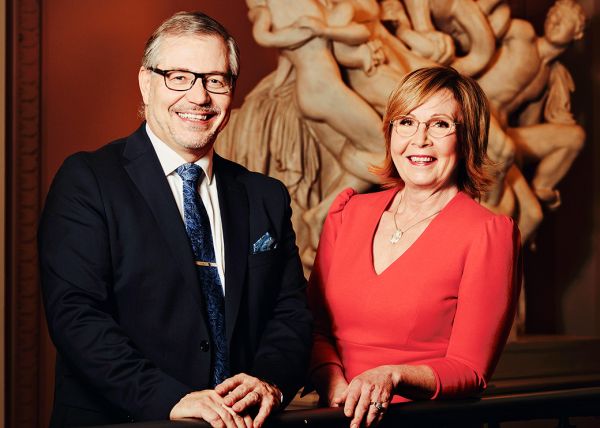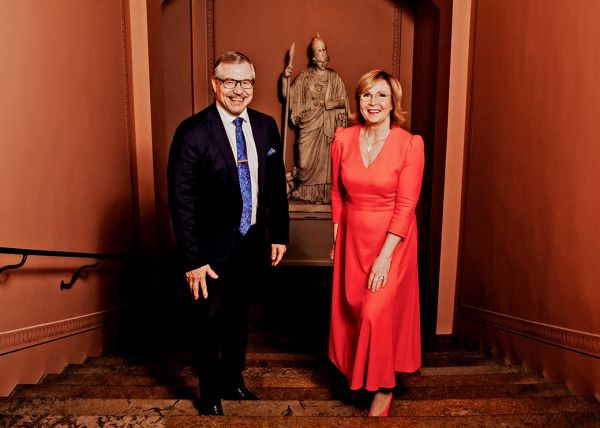
Leadership in academic work is interaction above all
University of Helsinki Rector Sari Lindblom and Tampere University Rector Keijo Hämäläinen lead by listening. In addition to presence and ears, you need Teflon and an occasionally activated parrot mode.
Text minna hiidensaari images sabrina bqain english translation marko saajanaho
What is the weakest link here? This is often the question an academically inclined person approaches issues with. It is also exactly what spices up leadership in academic work.
“Scientific thinking and argumentation are visible at the university even in everyday life. The discourse culture is fundamentally critical”, says Tampere University Rector Keijo Hämäläinen.
University of Helsinki Rector Sari Lindblom echoes the sentiment.

“The most talented and smartest people are at universities. At the same time, they know how to be demanding and know their own worth. Everything must be challenged. And it should be. Universities are also places with little hierarchy.”
The University Act places specific demands on academic leadership.
“There are many legal obligations. We have training requirements, we must be effective, productive, and successful. The main leadership challenge is accountability in every direction, including the needs or society, the country, and the university community. We must communicate with the ministry, our colleagues, and the international university world.”
”The main leadership challenge is accountability in every direction, including the needs or society, the country, and the university community. We must communicate with the ministry, our colleagues, and the international university world.”
Sari Lindblom, Rector, University of Helsinki
The top management from the Helsinki and Tampere universities has gathered to discuss academic leadership. Both rectors have extensive experience of management work in a university environment. DPhil Sari Lindholm’s field is higher education, and she has served as a Professor of Higher Education at the University of Helsinki since 2004. Lindblom was appointed as the rector of the University of Helsinki earlier this year. In 2019, Lindblom filled in for predecessor Jari Niemelä during the latter’s sick leave and performed rector’s duties from 2020 to 2022.
The focus of Lindblom’s five-year term, starting in the beginning of August 2023, is improving wellbeing. His rectoral eye is equally on the values of the University of Helsinki, such as acculturation, truth, freedom, and community.
“The university is an expert organisation, and it takes time to grow into an expert”, Lindblom says.
”The rector leads the organisation’s culture and values. Leading is also enabling. Enabling individuals to realise their passions and attain success that way.”
Keijo Hämäläinen, Rector, University of Tampere
Keijo Hämäläinen was appointed as the Tampere University rector for a five-year term this spring. Hämäläinen’s primary focus is building trust within the university community. His field is physics, in which he has held a professorship at the University of Helsinki since 2002. His previous positions include Rector of the University of Jyväskylä and Vice Rector of the University of Helsinki.
“The rector leads the organisation’s culture and values. Leading is also enabling. Enabling individuals to realise their passions and attain success that way.”
You can always listen even better
Hämäläinen stresses that effective leadership is not so much about decision-making.
“The decision is just the starting point. Leadership is interaction above all. Things do not progress if there is too little interaction. You can always communicate and listen better, too. A leader is never the finished product”, Hämäläinen sums up his views.
Lindblom nods.
“Good leadership is people management and community building. If your people management does not work, neither does anything else in the organisation. The rector must be present and available, able to listen and appreciate the members of the community. You cannot escape abroad in this job.”

Both Hämäläinen and Lindblom have served as vice rectors at the University of Helsinki.
“When I started the job, Keijo told me to Teflon up. That does not mean becoming cynical, just that not everything should be taken personally. The rector must listen to people and be able to handle honest comments. Listening is most important of all, ignoring is the worst you can do”, Sari Lindblom says.
While interaction is the key to everything in leadership, the rectors’ experiences also identify it as the source of the biggest frustrations more often than not.
”In a big organisation, accidental misunderstandings can happen, or something can be misheard.”
Keijo Hämäläinen, Rector, University of Tampere
“In a big organisation, accidental misunderstandings can happen, or something can be misheard. It is important to make sure everyone stays informed. It gets frustrating when, for example, I have discussed something with seven different stakeholders, only for someone to ask why they haven’t been told about this”, Hämäläinen says.
“In the words of Osmo A. Wiio, communication always fails, except by accident”, he adds and smiles broadly.
Both agree that good leadership communication involves openness and integrity.
“I do not have any hidden messages, and my feedback has nothing between the lines”, Lindblom says.
“I do not have any hidden messages, and my feedback has nothing between the lines.”
Sari Lindblom, Rector, University of Helsinki
“Openness is a leadership tool. Commitment and argumentation take time but, if necessary, I will repeat my argument like a parrot. I speak as one human being to another and say what I am trying to achieve. I use the word ‘strategy’ very rarely. People often take it as something handed to us from outside or approved by the board. I would rather talk about goals and values”, Hämäläinen says.
lifestyle community going through constant change
Both also agree that the academic environment and commitment to it are characterised by how it is a constant presence in life.
“At the university, people feel they are part of a community, not so much that they are at work. I also say I’m going to the university, not that I’m going to work”, Hämäläinen says.
“It is a lifestyle”, Lindblom affirms.
Leading change is a constant companion of any academic leader.
“We have grown into the fact change is constant. Leading change may be the easiest part of this job”, Lindblom says.
”We have grown into the fact change is constant. Leading change may be the easiest part of this job.”
Sari Lindblom, Rector, University of Helsinki
“It is easy to lead a change if it has a specific direction, with clear arguments for it and a consensus”, Hämäläinen states.
“Oscillation from outside brings challenges”, Lindblom confirms.
Indeed, one repeated source of frustration is the zero-sum game of the funding model.
“That is when you develop the operations and invest on getting results through one method, but then someone changes the rules, and all the work is wasted. That completely undermines leadership. Plenty of research gets done with complementary funding. We are often in a reactive mode even though we should be managing the big picture”, Hämäläinen critiques.
Tension between leadership and science
How do the rectors see the pressures of middle management? Lindblom is especially familiar with deans struggling amidst the tension of communicating in multiple directions.
“For this exact reason I have included all deans in the management group. The University of Helsinki also has a Leadership Arena of a hundred people, which gathers regularly.”
In Lindblom’s opinion, competence development should be tailored individually.
”The closer your work gets to research groups, the more your leadership is scientific leadership”
Keijo Hämäläinen, Rector, University of Tampere
Hämäläinen would not use the term “middle management”, preferring to talk about faculty and department heads instead.
“The role of the deans is emphasised. They are great leaders.”
He also sees the deans’ networking as important.
“I believe in collegial management group work.”
One additional twist for those responsible for operative leadership is the fact not everyone wants to embark on the management path.
“The challenge is combining a demanding management role with a break in your research career”, Hämäläinen says.
Lindblom and Hämäläinen see the dividing of management responsibilities as fundamentally clear. Top management handles the full picture and finances, for example.
“The closer your work gets to research groups, the more your leadership is scientific leadership”, says Hämäläinen.
Repeated friction is caused by, for instance, the research groups being independent on one hand and subject to the university’s employer role and decision-making on the other.
Critical diversity enriching the field
Is Finnish university management uniform?
“Management is probably quite different in different universities. They have different cultures. The legal forms, boards, and university sizes vary”, Lindblom reckons.
“Personality is emphasised in leadership. Different managers have different competences, as they should. There must be critical diversity. One place uses Excel for convincing, another uses rhetoric. Different universities are also in different phases, which is highlighted through their choice of rector”, Hämäläinen describes.
According to Lindblom, universities should not be compared to each other. The goal of any leader is to make their university succeed and thrive. Nothing in the current system encourages cooperation between universities, either.
Need for support in managing difficult situations
According to both rectors’ experiences, one area of development is managing difficult situations.
“Conflict situations, coping problems, and early intervention on poor behaviour and alcohol problems require coaching support. Escalation should be prevented”, Hämäläinen lists.
Lindblom recognises the phenomenon.
“Bringing up such issues is considered difficult. Issues of maintaining working capacity are often raised in mutual conversations.”
Mental health issues have drastically increased in higher education.
“The biggest challenge is polarisation. Some excel, succeed, and enjoy whereas others end up struggling. The need for individual support has increased. The COVID years increased this polarisation. The pandemic years were easy for some, difficult for others. There has been no time to recover as new crises have emerged. Building hope is important”, Lindblom observes.
“For example, if your thesis isn’t progressing, it is crucial to recognise a potential mental health issue”, says Hämäläinen.
“On the other hand, the increase in mental health issues is also due to them no longer being taboo”, Lindblom reminds us.
Close union of freedom and responsibility
How about working within the framework set by the Ministry of Education and Culture’s funding model? Does that eat away at academic freedom?
“Freedom always comes with associated responsibility. Academic freedom does not mean someone may freely keep running the same course with no changes year after year”, Lindblom articulates.
“Wise words from Sari, as usual. The Ministry’s money distribution model does not limit academic freedom and largely brings efficiency metrics to university work. External guidance does not need to be accepted as is, nor should it be taken personally. The big picture is built at the faculty level. The goal is to enable things”, Hämäläinen summarises.
Keijo Hämäläinen
Tampere university recor,
professor of physics
- Born: 1963 in Viitasaari, Finland
- Work: Tampere University Rector 2023–; University of Jyväskylä Rector 2017–2023; University of Helsinki Vice Rector 2014–2017; Dean at University of Helsinki 2010–2013
- Family: Wife and two children, two grandchildren
- Hobbies: Cottage holidays, fishing, orienteering, good food
- What are you known for in your work community? “Never shuts up”
- What are you not known for? Participating in the same ski jumping contest as Matti Nykänen
Sari Lindblom
Helsingin yliopiston rehtori, filosofian tohtori, yliopistopedagogiikan professori
- Born: 1960 in Helsinki, Finland
- Work: University of Helsinki Rector 2020–; Vice Rector 2017–2020; Head of Higher Education Department 2004–2016; Vice Dean for Research at University of Helsinki Faculty of Behavioural Sciences 2014–2016
- Family: Husband, three adult sons, two grandsons, daughters-in-law
- Hobbies: Cooking and exercise in various forms, especially running
- What are you known for in your work community? Positivity, efficiency, and quickness
- What are you not known for? Almost being a musicologist and musician in a “former life”

